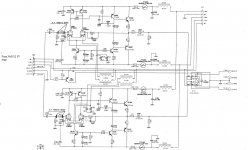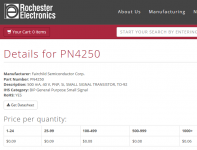Remember guys that the voltage noise of a bipolar transistor is equal 1/2Gm+Rbb'. At 1ma this is 13+Rbb'; at 10ma is 1.3+Rbb' so usually we don't operate that high in current, except for very low Rbb' devices.
Of course, at 100uA the effective noise RESISTANCE is 130+Rbb', so now BETA becomes more important, because we usually have to figure in an I(noise) contribution that is proportional to beta with source resistances over 50 ohms or so. This is where the beta droop of the 2N2219 could really effect things, and another, higher beta (at 100ua) device might be better, even if the Rbb' is somewhat higher.
Thanks John - that really gives good insight!
Jan
Last edited:
Dr. Marshal Leach wrote an article on low noise design for the Proceedings IEEE, Oct. 1994, titled "Fundamentals of Low-Noise Analog Circuit design". It's more theoretical than the Netzer article but very good.
@AMMEL68
Did you consider using the Texas Instruments LM6121?
http://www.ti.com/lit/ds/symlink/lm6221.pdf
@AMMEL68
Did you consider using the Texas Instruments LM6121?
http://www.ti.com/lit/ds/symlink/lm6221.pdf
@AMMEL68
Did you consider using the Texas Instruments LM6121?
http://www.ti.com/lit/ds/symlink/lm6221.pdf
No, I have never tried the 6121.
Looks as though they've been discontinued, unless you know of a source.
The 2N2222 has been mentioned as an early linear transistor still being used. I found in my garage some NOS 2N2222A and tested for noise:
10Hz 100Hz 1KHz 10KHz 100KHz
4.5nV 3.3nV .9nV 1nV .9nV
3mA/15v Beta = 133 @ 5mA
I'll compare with some new 2N2222A on order.
THx-RNMarsh
10Hz 100Hz 1KHz 10KHz 100KHz
4.5nV 3.3nV .9nV 1nV .9nV
3mA/15v Beta = 133 @ 5mA
I'll compare with some new 2N2222A on order.
THx-RNMarsh
Last edited:
The 2n2484/pn2484 was also listed as a low noise transistor. Jensen used this in the JE990 as THE CCSink transistor. GRH
The 2n2484/pn2484 was also listed as a low noise transistor. Jensen used this in the JE990 as THE CCSink transistor. GRH
I have that one... I already tested it also but it isnt as quiet as many others. If you need the numbers for SIM models, I can give it to you but it isnt a good low noise transistor at 1-3mA. It may have other redeeming qualities.
THx-RNMarsh
Last edited:
Forgot to include a link to the noise article by Professor Leach.
http://users.ece.gatech.edu/~mleach/papers/AnalogNoise.pdf
ammel68,
You can probably locate some NOS or a replacement. I used the LH0002 in filters 30 years ago and they were discontinued but they were so popular that another company made a replacement.
MSK0002 General Purpose Current Amplifier Designed and Made by MS Kennedy
http://users.ece.gatech.edu/~mleach/papers/AnalogNoise.pdf
ammel68,
You can probably locate some NOS or a replacement. I used the LH0002 in filters 30 years ago and they were discontinued but they were so popular that another company made a replacement.
MSK0002 General Purpose Current Amplifier Designed and Made by MS Kennedy
The 2N2222 has been mentioned as an early linear transistor still being used. I found in my garage some NOS 2N2222A and tested for noise:
10Hz 100Hz 1KHz 10KHz 100KHz
4.5nV 3.3nV .9nV 1nV .9nV
3mA/15v Beta = 133 @ 5mA
THx-RNMarsh
At 1mA/15v the noise is --
3/1.2/.9/.85/1.0nV
Last edited:
Now Richard, try the 2N2222 at 100uA and a 10K source. Then try a 2N5087, or 2N5089 and compare.
See if you guys can guess where this dac's output stage/buffer is from. With these transistor it could drive horns with a couple of mods.
Cheers George
Not sure where it's from, but I'm not crazy about the 10uF caps on the outputs of the buffers.
See if you guys can guess where this dac's output stage/buffer is from. With these transistor it could drive horns with a couple of mods.
Cheers George
Probably Luxman.
I guess adding a DC servo or offset trim was not stable enough. During warmup there will be a lot of DC shift with tubes. Anyone watching a Tek 547 warming up would be familiar with the problems. The NE5534 I/V converter is the real limitation. I presume its an older design.
Not sure where it's from, but I'm not crazy about the 10uF caps on the outputs of the buffers.
Probably Luxman.
It's the MF trivista dac,
Yes I think the caps can be eliminated by carefull adjustment of the dc offset, but it still had a small switch on bump.
I've shown how to do this on the same/ different model which has the same output stage, the MF A3-24 a few years back in another thread, with circuit diagram. But then this one has tube input so it may not be successful
Cheers George
Last edited:
Mr. Marsh,
If you have a 2N4250 in you stock, please show noise results. The reason I ask is because years ago I was looking for that transistor and found it in the Central Semiconductor catalog. Central Semiconductor told me the 2N4250 part number was obsolete and to use 2N5087 instead. I'm interested in a comparison.
If you have a 2N4250 in you stock, please show noise results. The reason I ask is because years ago I was looking for that transistor and found it in the Central Semiconductor catalog. Central Semiconductor told me the 2N4250 part number was obsolete and to use 2N5087 instead. I'm interested in a comparison.
Now Richard, try the 2N2222 at 100uA and a 10K source. Then try a 2N5087, or 2N5089 and compare.
2N5087 is PNP, the original complement was the 2N5089 but the 2N5210 became a better choice. So those would be the righ ones to compare to a 2N2222
The issue with most of the transistors under discussion was that I believe they are straight NPN or PNP construction so the beta vs current curve is not very flat. Of course when used with a current source that is not much of an issue.
Later transistor designs are more complex to prevent base spreading among other improvements.
I still keep all of these in stock and use them.
Richard is almost convincing me to get a Quantech, although I probably will try a few other techniques first. Maybe even build a modern DIY version. Of course I am overloaded with work for now.
- Home
- Source & Line
- Analog Line Level
- Discrete Opamp Open Design

